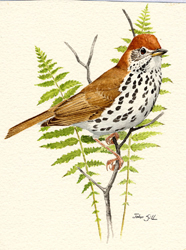Breeding Bird Atlases (BBA)
Find a Bird - BBA1
Breeding Bird Atlas 1 Species Accounts
Wood Thrush
Hylocichla mustelina
Egg Dates
May 14 to June 26
Number of Broods
one, rarely two; may renest if first attempt fails

The Wood Thrush has become, in recent decades, a common breeding species throughout most of Massachusetts, where it now nests regularly in suitable habitat. The species is notably scarce only on Cape Cod, the Islands, and coastal areas in general where appropriate woodlands for breeding are lacking. Unfortunately, at the same time that the Wood Thrush has been extending its breeding range northward in New England, the species is doubtlessly experiencing loss of winter habitat due to deforestation in Central America.
The Wood Thrush is still a fairly common spring migrant. Peak movement is during the second and third weeks of May, although some individuals arrive in late April. Males begin singing almost immediately upon arrival. Like that of other thrush species, the song is flutelike, loud, and somewhat ventriloquial. The song, a series of phrases consisting of four notes followed by a short, high, wispy trill, is most frequently given at dawn and dusk. The common call is a series of sharp pit-pit-pit notes. Courtship includes rapid pursuit flights of the female by the male.
The Wood Thrush’s preferred nesting habitat is mature, moist deciduous forest with an understory of shrubs and young trees, although the species can also be found in dry woodland. Apparently, the Wood Thrush can tolerate some human activity and has adapted to nesting in small forest patches and even in shrubby vegetation in suburban areas. Habitats for 12 Massachusetts nests were mixed woodland (8 nests), deciduous woods (1 nest), suburban yard (3 nests) (CNR). The cup-shaped nest, built by the female, is placed in a notch or forked branch of a shrub or sapling, usually 5 to 10 feet above the ground. Occasionally, the nest is built higher up in a mature tree.
In Massachusetts, 20 nests were located as follows: deciduous trees, including apple and oak (7 nests); conifers, including Red Cedar, Red Pine, White Pine, and Jack Pine (7 nests); shrubs and bushes, including laurel, viburnum, honeysuckle, and lilac (6 nests) (CNR). Heights of 17 of these nests ranged from 3 to 20 feet, with an average of 6.9 feet (CNR). Grasses and weed stalks are used to construct the outer layer; a middle layer of mud, wet leaves, and grass is then added. Finally, the cup is lined with moss or fine rootlets. Also, bits and pieces of paper are frequently incorporated into the structure.
Three or four (sometimes five) eggs are laid, and clutch sizes for 17 Massachusetts nests were three eggs (8 nests), four eggs (8 nests), three eggs plus one cowbird egg (1 nest) (CNR, DKW). Known state laying dates were May 20 to May 23 and May 23 to May 26, and known state hatch dates were June 4, June 5, June 17, and June 18 (CNR). The female incubates the eggs for 12 to 14 days, but the nestlings are tended by both parents. Food brought to the young includes insects and other invertebrates as well as berries later on. If the nest or young are threatened, the adults give a loud distress call, which is a tswack note repeated four or five times. Nestlings have been recorded in Massachusetts from June 3 to June 24. Brood sizes for 10 state nests were three young (3 nests), four young (6 nests), one youngster in a nest disturbed by cowbirds (CNR).
The altricial young have some light gray natal down; and their eyes do not open until about the fifth day, but by the third day the sheaths of the wing and tail feathers begin to appear. The young are alert, well feathered, and more active after the ninth day. Fledgling Wood Thrushes, which leave the nest at about 12 days of age, have been observed in the state from June 12 to July 10 (CNR, Meservey). While some pairs may raise two broods, it is generally believed that one brood a season is more typical. The birds will often renest if the first attempt fails. The young are fed by the parents for a week or more after fledging. Both adults and immatures remain in the vicinity of the nesting territory for some time after the young become independent. During this period, adults undergo a complete postnuptial molt, replacing wing and tail feathers as well as the body plumage. At the same time, the young replace their body feathers, losing most or all of the tawny olive spots on the back and wing coverts to become virtually indistinguishable from the adults.
The fall migration of Wood Thrushes begins in late August and peaks during September, although the number of birds seen on any given day is never large. Some migrants are found into October, and there are occasional November reports and even a few Christmas Bird Count records, especially along the coast; but there is no evidence of successful overwintering in Massachusetts. Wood Thrushes winter over a fairly narrow range, preferring tropical forests from southern Mexico to Panama.
Map Legend and Data Summary
Atlas 1 data collected from 1975-1979


Note: common in deciduous woodlands; much less common on the Cape and Islands
Christina Dowd



